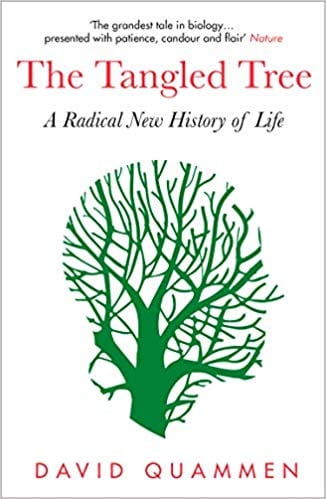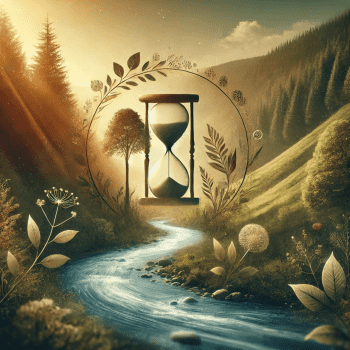Charles Darwin was born two hundred and eleven years ago this Wednesday, on February 12, 1809. And in recent years his birthday has been celebrated as International Darwin Day, an annual opportunity to celebrate the principles that guided his life: “perpetual curiosity, scientific thinking, and hunger for truth.”
As brilliant as Darwin was, a lot of additional scientific discoveries related to evolution have been made in the more than one hundred years since his death (202). So in the spirit of Darwin Day, I would like to invite us to take a brief tour of where those same characteristics of “perpetual curiosity, scientific thinking, and hunger for truth” that led to Darwin’s great discovery have taken scientists who have come after Darwin. In particular, I would like to focus on one recent and significant paradigm shift in the understandings of evolution called “horizontal gene transfer.”
In contrast to the recent breakthroughs related to horizontal gene transfer, Darwin conceived of evolution vertically. His primary metaphor was the tree of life that began at the root level with simpler life forms only to grow up and branch out into increasingly complex forms of life (6). Indeed, the only illustration in the first edition of Darwin’s 1859 book On the Origin of Species by Means of Natural Selection was a tree-life graphic of species branching up and out over time (32-33).
For Darwin, all living beings (including we human beings) are related due to our evolution from a common ancestor—what is called “common descent.” Over time, the ascending lines of species could diverge (or “branch out”), but those branches did not converge or come back together. In the traditional understanding of evolution, “genes flow only vertically (up the tree of life), from parent to offspring, and can’t be traded sideways across species” (xi). But it turns out that the tree of life is much more “tangled” than Darwin realized.
 If this post leaves you curious to learn more, I recommend the book The Tangled Tree: A Radical New History of Life by David Quammen, which The New York Times named as one of their top 100 books of 2018.” Quammen is both a clear writer about technical topics and a weaver of many fascinating stories about the scientists behind the breakthrough discoveries.
If this post leaves you curious to learn more, I recommend the book The Tangled Tree: A Radical New History of Life by David Quammen, which The New York Times named as one of their top 100 books of 2018.” Quammen is both a clear writer about technical topics and a weaver of many fascinating stories about the scientists behind the breakthrough discoveries.
Now, in the spirit of full disclosure, we’re going to get a little nerdy, but stick with me because it’s going to take us to some interesting places. For instance, consider that our human cells originally evolved not only
gradually in the typical Darwinian manner of gene mutation and natural selection…. Our mitochondria came aboard suddenly…as captured bacteria. Plants acquired their chloroplasts the same way. Our genomes are mosaics…. Roughly 8 percent of the human genome consists of the remnants of retroviruses that have invaded our lineage—invaded the DNA, not just the bodies, of our ancestors—and stayed. We are at least one-twelfth viral, at the deepest core of our identities. (349)
Such insights are arguably part of the third revolution in evolutionary science, with the first beginning with Darwin, the second with Mendel and genetics, and the fourth potentially on the horizon with the genome-engineering power of CRISPR.
And although understanding the origins of life is important in itself, one of the most practical reasons to better understand this phenomenon is that horizontal gene transfer is a major contributing factor to the rapid evolution of antibiotic resistant bacteria (such as the super bug MRSA) that is very much still happening in our own time (239).
Thinking back, I can’t remember with certainty if I learned about horizontal gene transfer when I took a formal Biology class in the mid-1990s. But scientists have been taking increasing note of horizontal gene transfer since the 1980s (255). And the study of this phenomenon became much easier and faster in the mid-1990s due to technological advances related to the Human Genome Project, which mapped all the genes in our human DNA (274).
Also since the film Dolittle is in theaters these days, let me relatedly tell you about a real-life Dr. Dr. Ford Doolittle (1941-), who is an evolutionary and molecular biologist and currently a professor emeritus at Dalhousie University in Nova Scotia. I love the story about him, that in 1998, the journal Science contacted him for a recommendation of someone who could write an article from a microbiology perspective for their upcoming special issue on evolution.
To their surprise he nominated himself. When he added that he wanted to use this opportunity to raise awareness in the scientific community about the under-appreciated importance of horizontal gene transfer, they were not wild about the idea, but it would have been too rude at that point to rescind the offer (283). His article, published the next year in 1999 was even more successful that he could have hoped: “Suddenly horizontal gene transfer seemed a mainstream idea, an ongoing process of major importance at least in microbial evolution—something that had to be considered and discussed—rather than a hallucination, an artifact, or a quirk” (287).
And keeping in mind that single illustration that Darwin had included in his first edition of Origin, Doolittle’s article included an important sketch that riffed on Darwin’s tree of life. Doolittle called it a “reticulated tree” from the verb meaning to “divide or mark (something) in such a way as to resemble a net or network.” I find that fascinating: thinking of evolution less as a tree and more as a net or network. Doolittle’s reticulated tree had branches not only going out and up, but also making many connections weaving in and out horizontally—almost like a bramble or thicket. (285).
The more scientists have dived into this new paradigm, the deeper the rabbit hole seems to go, kind of like those Matryoshka “Russian nesting” dolls: with each one that you remove, there’s still another inside. Specifically, remember what I shared earlier about how bacteria captured early in eukaryotic cells became mitochondria in our cells, and chloroplasts in plant cells? Well, scientists have further discovered that those pivotal bacteria:
had themselves been recipients of horizontal gene transfer, from different kinds of bacteria, before their capture. This means that parts of genomes existed within other genomes before becoming parts of still other genomes, including yours. It is all a snarl…a mess…a plate of spaghetti (295).
So although evolution is not as classically majestic as a tree, that intricate web of genetic inheritance remains compelling nonetheless.
To underscore my primary takeaway from exploring this still-developing corner of science, horizontal gene transfer strikes me as a powerful reminder of what my tradition of Unitarian Universalism calls our Seventh Principle, “Respect for the interdependent web of all existence of which we are a part.” We humans are incredible animals in so many ways, but not because we were spoken into existence a few thousand years ago in a separate, special act of creation. Thinking and acting along those lines has gotten us to a point of climate catastrophe. We must learn to understand ourselves as evolving through a process that is deeply intricate, interwoven, and interdependent with the other forms of life and ecosystems of this planet.
Evolution has often been understood as almost exclusively about the “survival of the fittest.” In Tennyson’s words, “Nature, red in tooth and claw.” But in the words of one scientist: more than a century after Darwin’s death, we are coming to a fuller understanding of evolution as “much more about mergers and acquisitions and collaboration than about change within isolated lineages. It is about not just the divergence of branches but also their inosculation”—a fancy word for when “trunks, branches or roots of two trees grow together” (304).
I find these scientific shifts astonishing. And since microbiology, bacteria, and viruses are such crucial parts of horizontal gene transfer, allow me to move toward my conclusion with one more story that exemplifies the Darwin Day spirit of “perpetual curiosity, scientific thinking, and hunger for truth.” All this talk of microbiology also reminded me of someone I hadn’t thought much about in decades—not since those aforementioned days of high school AP Biology II. The person I’m thinking of is Antonie van Leeuwenhoek (1632-1723), a Dutch businessman who is best remembered for being “the Father of Microbiology” (11).
Back in the 1670s, more than 150 years before Darwin, Leeuwenhoek made his living as a draper: he owned and operated a drapery shop. And at first, he began making magnifying lenses to more accurately ascertain the thread-count on his draperies. By chance, the idea occurred to him to examine other items under his magnifying lenses. To his astonishment, he discovered an abundance of tiny creatures swimming around in various nearby water samples that he gathered—as well as tiny creatures swimming around in scrapings that he took from his own mouth (12). Can you imagine how shocking and disturbing that first glimpse of microbiology must have been!
I also love that microbiology was founded when some dude, who was simply trying to make sure that his thread count was on point, happened to stumble backward into a whole other level of reality—one that was teeming with life—that had been there all along. We just hadn’t noticed yet! From that happenstance discovery, so much has flowed. We now know that:
the total mass of bacteria exceeds the total mass of all plants and animals on Earth…. There may be more than a billion bacterial cells in an average ounce of soil, and five million in a teaspoon of fresh water…. A single kind of marine bacteria…which drifts free in the world’s tropical oceans and photosynthesizes like a plant, may be the most abundant creature on Earth. One source places its standing population at three octillion individuals….” (86).
That’s a three followed by twenty-seven zeros. And with the discovery of horizontal gene transfer, we are increasingly aware of how all those teeming hordes of bacteria are much more deeply woven into ourselves than we could have previously imagined.
Our awareness of this micro-aspect of our reality came from an individual closely observing how the world actually is—which can often be quite different than what we have been told. Darwin did likewise. He was a naturalist who spent incredible amounts of time tracing, logging, and comparing various forms of life: discovering what forms of life are actually out there—and how they evolved—beyond what had been previously known.
The philosopher Ludwig Wittgenstein used to say it this way: “Don’t think — but look and see!” Don’t think you know how the world is. Look and see. You might be surprised what you discover.
So, continuing in the Darwin Day spirit of “perpetual curiosity, scientific thinking, and hunger for truth,” I will conclude with the final paragraph of Darwin’s 1859 book On the Origin of Species. Whereas many scientific texts are often not well written and become obsolete after new discoveries are made, Darwin’s books have been widely praised for both the beauty of his prose and for being well worth revisiting even more than a century and a half later. So, I invite you to consider anew these words from the conclusion to Origin. Note that Darwin begins by naming aspects of life we often perceive as solely negative—then shows how those very things are essential to the engine of evolution. In Darwin’s words:
from the war of nature,
from famine and death,
the most exalted object which we are capable of conceiving…
the production of the higher animals,
directly follows.
There is grandeur in this view of life…; and
whilst this planet has gone cycling on
according to the fixed law of gravity,
from so simple a beginning
endless forms
most beautiful and
most wonderful
have been,
and are being,
evolved.
The Rev. Dr. Carl Gregg is a certified spiritual director, a D.Min. graduate of San Francisco Theological Seminary, and the minister of the Unitarian Universalist Congregation of Frederick, Maryland. Follow him on Facebook (facebook.com/carlgregg) and Twitter (@carlgregg).
Learn more about Unitarian Universalism: http://www.uua.org/beliefs/principles
















